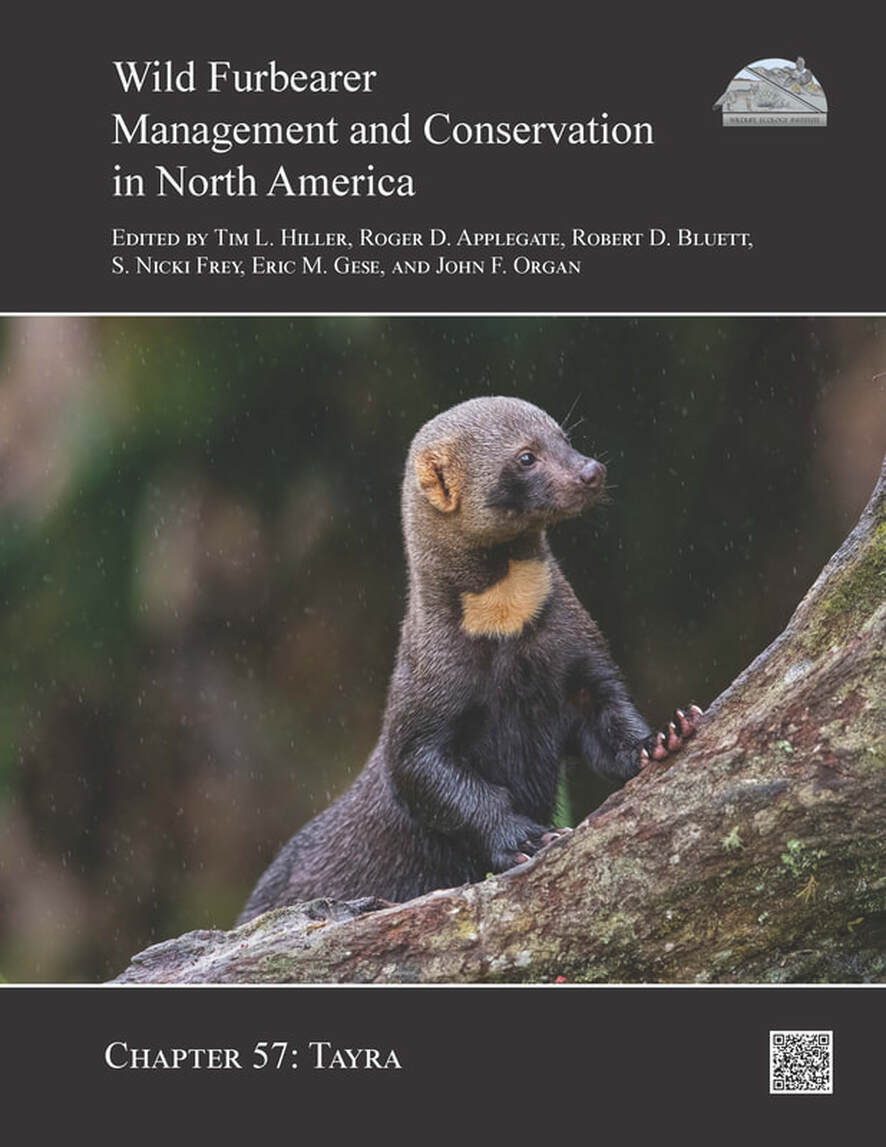For information about this book, including the Table of Contents, click here.
Published 28 February 2024
© 2024 Wildlife Ecology Institute
https://doi.org/10.59438/NQHK8628
© 2024 Wildlife Ecology Institute
https://doi.org/10.59438/NQHK8628
INTRODUCTION
The tayra (Eira barbara) is a member of the Order Carnivora, Family Mustelidae, and is the only extant species of the genus Eira. Based primarily on pelage coloration, Cabrera (1958) and Hall (1981) noted seven different phenotypes which they recognized as subspecies. Presley (2000) mentioned the yellow morph as an additional phenotype, which has not been assigned a subspecies designation. Partial DNA analysis by Ruiz-García et al. (2013) of specimens from South America indicated that in the southern distribution of the species, the five phenotypes (recognized by other authors as subspecies) present in the region include only two subspecies.
The genus for the tayra, Eira, comes from the common name used by indigenous peoples of Bolivia and Paraguay for this species, whereas the species, barbara, comes from the Greek word barbarous, meaning strange or foreign (Gotch 1979, Presley 2000). This species has different common names throughout its geographic distribution, including cabeza de viejo, viejo de monte (Mexico); bushdog (Belize); perico ligero (Guatemala); lepasil (Honduras); tolomuco (Costa Rica); comadreja grande, gato cutarra, gato negro (Panama); guanaco (Venezuela); cocoromao, guacho, ulama, zorro ulama, zorro ulamat (Colombia); guamingo, marimonta, omayro, taira (Peru); perro de monte, tejón manco, ucate (Peru and Ecuador); cabeza de mate, humayro (Ecuador); melero (Bolivia); airá, eirá, eira, eira moro, gato eira, hurón mayor, mbaracayá eirá, taira, yrara (Paraguay); ariranha, irara, papa-mel (Brazil); and hurón mayor (Argentina).
The tayra (Eira barbara) is a member of the Order Carnivora, Family Mustelidae, and is the only extant species of the genus Eira. Based primarily on pelage coloration, Cabrera (1958) and Hall (1981) noted seven different phenotypes which they recognized as subspecies. Presley (2000) mentioned the yellow morph as an additional phenotype, which has not been assigned a subspecies designation. Partial DNA analysis by Ruiz-García et al. (2013) of specimens from South America indicated that in the southern distribution of the species, the five phenotypes (recognized by other authors as subspecies) present in the region include only two subspecies.
The genus for the tayra, Eira, comes from the common name used by indigenous peoples of Bolivia and Paraguay for this species, whereas the species, barbara, comes from the Greek word barbarous, meaning strange or foreign (Gotch 1979, Presley 2000). This species has different common names throughout its geographic distribution, including cabeza de viejo, viejo de monte (Mexico); bushdog (Belize); perico ligero (Guatemala); lepasil (Honduras); tolomuco (Costa Rica); comadreja grande, gato cutarra, gato negro (Panama); guanaco (Venezuela); cocoromao, guacho, ulama, zorro ulama, zorro ulamat (Colombia); guamingo, marimonta, omayro, taira (Peru); perro de monte, tejón manco, ucate (Peru and Ecuador); cabeza de mate, humayro (Ecuador); melero (Bolivia); airá, eirá, eira, eira moro, gato eira, hurón mayor, mbaracayá eirá, taira, yrara (Paraguay); ariranha, irara, papa-mel (Brazil); and hurón mayor (Argentina).
Citation:
Villafañe-Trujillo, Á. J., and C. A. López-González. 2024. Tayra. Pages 57.1–57.23 in T. L. Hiller, R. D. Applegate, R. D. Bluett, S. N. Frey, E. M. Gese, and J. F. Organ, editors. Wild furbearer management and conservation in North America. Wildlife Ecology Institute, Helena, Montana, USA. https://doi.org/10.59438/NQHK8628
Citation:
Villafañe-Trujillo, Á. J., and C. A. López-González. 2024. Tayra. Pages 57.1–57.23 in T. L. Hiller, R. D. Applegate, R. D. Bluett, S. N. Frey, E. M. Gese, and J. F. Organ, editors. Wild furbearer management and conservation in North America. Wildlife Ecology Institute, Helena, Montana, USA. https://doi.org/10.59438/NQHK8628
Copyright 2024 Wildlife Ecology Institute



